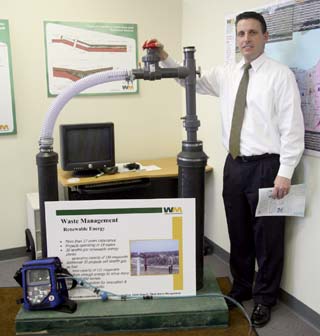
A proposed new building on the Mill Seat Landfill site in Riga would house the equipment necessary to generate electric power from gas created in the decomposition of landfilled materials. The 10,000 sq. ft. power plant, located on the east side of Brew Road not far from the Town of Bergen line, will cost $8.5 million. According to Waste Management District Manager Jeff Richardson, the project to convert methane gas to electricity will yield 6.4 megawatts, “enough electric power to serve 6,000 homes.” Landfill operator Waste Management held an open house February 27 and 28 at the Monroe County-owned landfill’s administration building to explain to visitors what was involved in the ‘green’ (environmentally friendly) effort. Instead of collecting and burning the methane generated by decomposing organic waste material in the landfill, the gas will be burned and used to drive turbines to create electricity in the new building. Richardson said the landfill consists of layers of waste interspersed with layers of sludge from the Van Lare water treatment plant in Rochester. The sludge contains microbes, a vital element in accelerating the decomposition of organic material, working much like a septic system. The sludge and waste material is mixed on-site daily, using bulldozers. The breakdown product is primarily a 50-50 mixture of methane gas (a component of natural gas) and carbon dioxide. This product, made 24-hours a day, seven days a week, is collected in horizontal pipes that were laid down as the waste material piles were built. When the waste material piles are big enough, vertical pipes (wells) are installed. These are then interconnected to funnel the gaseous product to a flare, a tall metal column where the gas is burned. Town of Riga Supervisor Pam Moore said she supports this effort to mitigate the environmental impact of the landfill. “The environmental consequences of using unregulated dumps came to light in the 1970s. It is good that corporations, such as Waste Management, are beginning to apply technology to move us beyond just burying waste,” she said. “As a society, we still have much work to do to solve the problems associated with the generation of solid waste and we need to look beyond landfills as a solution, In the meantime, this technology to use the methane gas to create energy is a positive step.” Last year, Waste Management personnel reported that about 1.1 billion cubic feet of gas was burned, an amount equivalent in energy to over 110,000 barrels of oil, according to landfill officials. The new process is expected to save money by using a formerly wasted product, reduces the creation of carbon dioxide emitted and thus is an aid to the environmental balance. The company reports that the new system to conserve energy is now being used in landfill gas energy projects throughout the country with nearly 400 operational, 16 of those in New York state. In 2004, according to Waste Management’s statistics, 9 billion kilowatt hours of electricity and 74 billion cubic feet of landfill gas were generated. If approved, Richardson said ground will be broken by the end of the second quarter of this year and the plant should be generating electricity by the end of the year. The power will be fed to a main electric distribution line on Sanford Road in Churchville. “The plant will be largely automatic in operation,” Richardson said. “It only requires two people to run it.” Waste Management is currently in the permitting process for the project which needs state, county and town approval. That done, the project could then go out to bid. March 5, 2006 |
